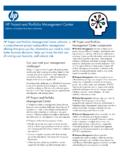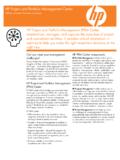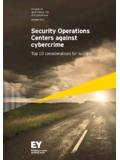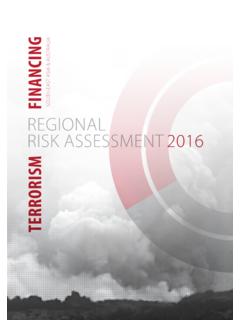Transcription of What Is ERP and Why Do I Need It - Fitrix
1 What Is ERP and Why Do I Need It? Enterprise Resource Planning (ERP) is an enterprise-wide information system that facilitates the flow of information and coordinates all resources and activities within the organization. An Executive Whitepaper Presented by Fourth Generation Software, makers of February, 2011 What Is ERP and Why Do I Need It? PAGE 2 Highlights: ERP is an enterprise-wide information system that facilitates the flow of information and coordinates all resources and activities within the business organization. Of all the software an organization can deploy, ERP has potentially the most direct impact on reducing costs. ERP solutions are effective for reducing costs through improving efficiencies and decision-making.
2 Competitive advantages arise to firms that can contain costs so that increased revenues translate into higher profits. Effective solutions open to door to vast business process improvements as indicated by better customer service, smoother functioning business, decision support, eliminating IT barriers to growth, and the coordination of various business What Is ERP? ERP stands for Enterprise Resource Planning. ERP is an enterprise-wide information system that facilitates the flow of information and coordinates all resources and activities within the business organization. Functions typically supported by the system include manufacturing, inventory, shipping, logistics, distribution, invoicing, and accounting. Some solutions now embed customer relationship management functionality.
3 A wide variety of business activities including sales, marketing, billing, production, inventory management, human resource management, and quality control depend on these systems. The ERP system assists in managing the connections to outside stakeholders as well as enhancing performance management. It uses a centralized database and usually relies on a common computing platform. It provides the user a unified, consistent, uniform environment. ERP solutions evolved from applications focused on materials requirements and resource planning and computer integrated manufacturing. The Enterprise Resource Planning term came about when software developers were searching for a name that would more aptly describe these broader systems.
4 These new solutions provided functionality that encompassed other applications in addition to manufacturing. What Is ERP and Why Do I Need It? PAGE 3 Of all the software an organization can deploy, ERP has potentially the most direct impact on reducing costs. When asked in a 2010 survey conducted by the Aberdeen Group of Small and Medium Businesses (SMBs) what factors drove them to implement an ERP solution, nearly half cited the need to reduce costs to improve operating margins. Improving customer service was the second most cited reason. The distribution of responses to this survey appears below in Figure 1. Figure 1: Factors Driving ERP Adoption Source: Aberdeen Group survey, August 2010 A survey conducted during much the same period by AMR Research confirms these findings.
5 Fifty percent of their respondents named cost reduction and improved efficiencies among their top two priorities. Why Does the Small or Mid-Size Business Need ERP? The best firms are hungry for proven methods to streamline operations and improve their customers experience to enhance their competitive position and drive growth and the value of Enterprise Resource Planning (ERP) solutions is well established. What Is ERP and Why Do I Need It? PAGE 4 Competitive advantages arise to firms that can contain costs so that increased revenues translate into higher profits. A well-constructed and implemented ERP solution should reduce costs and increase productivity through improved operations. Standardizing business processes, which is required for the successful implementation of ERP, lays the groundwork for attaining improved efficiencies.
6 An effective implementation of an ERP solution optimizes the use of capital equipment and manpower. This in turn increases the importance of other ERP capabilities such as scheduling and resource planning. The SMB sector, which has on average seen greater growth rates than its larger counterparts, is suffering the consequences of a disconnect between what they have in their legacy systems and what they need to compete effectively in a highly competitive and increasingly global environment. A tool that provides insights into how to gain more efficiency from the organization is invaluable. Until now, most SMBs have struggled to squeeze the information they need for their operations out of a tangle of inadequate tools - for the most part consisting of stand-alone spreadsheets, accounting systems, desktop applications, and a patchwork of homegrown applications.
7 These tools lack the horsepower, breadth, and necessary integration to provide the insight managers need to transform their businesses. Lacking an ERP solution, firms, especially manufacturers, find themselves struggling to compete and grow using applications that are functionally deficient, obsolete, and isolated from other applications and data. These shortcomings manifest themselves in many ways that adversely affect the organization, some include: Inaccurate forecasts play havoc with inventory levels, Insight into innovative design engineering is clouded, Order tracking from acceptance through fulfillment is cumbersome or non-existent, The revenue cycle is obscured, Capacity is underutilized or overstrained, Cost overruns and missed deadlines taint customer relations.
8 Until now, most SMBs have struggled to squeeze the information they need for their operations out of a tangle of inadequate tools. What Is ERP and Why Do I Need It? PAGE 5 For many years smaller organizations thought they were too small to reap the benefits of ERP given the magnitude of the required investment. Solutions designed to fit their specific needs now allow smaller organizations to leverage the power of these systems to attain the same benefits that larger firms enjoy. New approaches to structuring system architectures have greatly simplified implementation and use and powerful solutions are now much more affordable to acquire and maintain. There are plenty of inexpensive software offerings that call themselves ERP solutions that are not full-function ERP.
9 There are dozens of add-ons to accounting packages such as QuickBooks or Sage Peachtree software a number of these run on an Access database, lack true ERP functionality and features, and are not scalable. Comparing these packages to a full-function ERP solution is like comparing a wheelbarrow to a front-end loader. The Benefits of Full-Function ERP Full-Function ERP solutions share certain characteristics that some of the lower products do not: They have more than a dozen integrated modules that address the breadth of the organization s needs. They can scale to grow with the organization. They contain a toolset that allows for user customization. They rely on a sophisticated, relational database with open access.
10 The vendor has a solid understanding of the market s wants and needs and is committed to meeting them through its offerings. One of the primary benefits of deploying a Full-Function ERP solution is the consolidation of often-dispersed data. The consolidation of data resulting from ERP use creates many organizational benefits: No need to synchronize changes between systems. Consolidates applications and brings more control to cross-functional processes for manufacturing, finance, human resources, marketing, and sales. Provides a real-time, enterprise-wide view of the business for faster and more effective decision-making. Shortens production lead times and delivery times. What Is ERP and Why Do I Need It? PAGE 6 Helps build a common vision throughout the enterprise.





